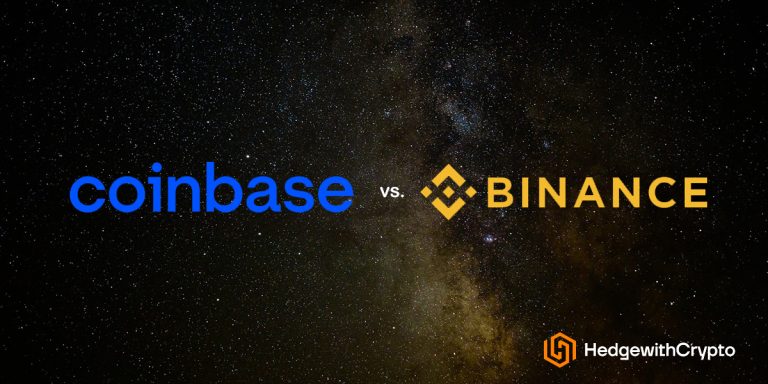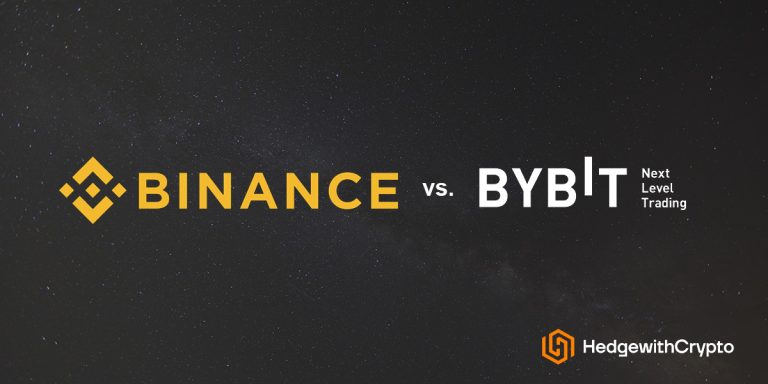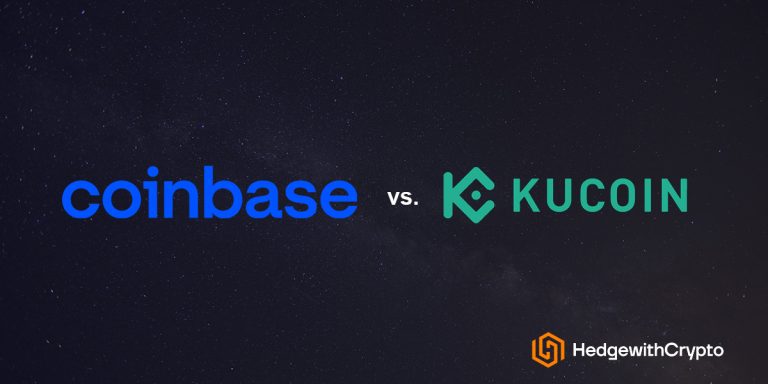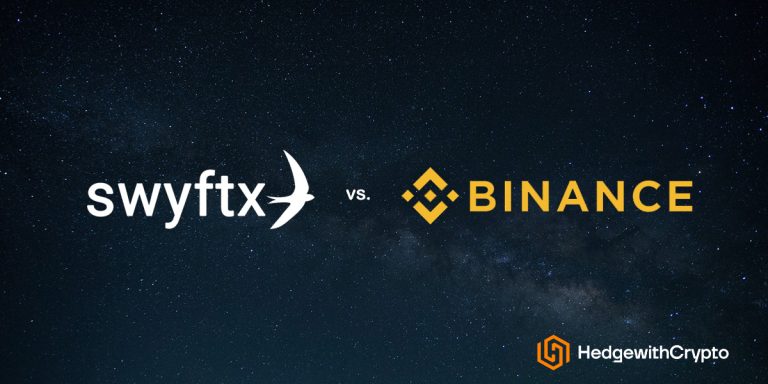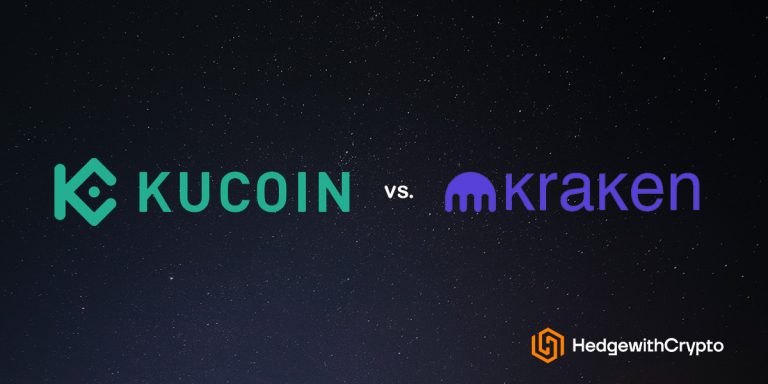We may earn a commission from links on our site, but this doesn’t affect our reviews. Learn more.
Hedge With Crypto is an independent publisher that provides objective and free content. Articles on our site may include links to our partners. If you click on these links, we may earn a commission. However, our editorial content remains unbiased, reflecting our own opinions or the general information available. For more information on our company policies, read the Affiliate Disclosure, Privacy Policy, and Terms & Conditions.
Binance vs KuCoin: Which Should You Choose?
Hedge With Crypto aims to publish information that is factual and accurate as of the date of publication. For specific information about a cryptocurrency exchange or trading platform please visit that provider’s website. This information is general in nature and is for education purposes only. Hedge With Crypto does not provide financial advice nor does it take into account your personal financial situation. We encourage you to seek financial advice from an independent financial advisor where appropriate and make your own enquiries.
TABLE OF CONTENTS
Quick Verdict – Binance vs KuCoin
Binance and KuCoin are two of the world's most popular crypto trading exchanges. The two platforms are quite similar, with each boasting an impressive list of features, altcoins, and competitive fees. Beginners may prefer Binance’s more regulated nature, while advanced traders might lean toward KuCoin’s range of derivative/margin trading tools. There is even a referral code to earn up to $300 for new users. Overall, Binance wins this comparison due to its better reputation, transparency, and quality of services.
| Binance | KuCoin | |
|---|---|---|
| Website |
|
|
| Promotion | Up to $100 welcome bonus | Up to 500 USDT in bonuses |
| Fiat Currency | USD, EUR, GBP, AUD, CAD, +22 Others | USD, GBP, EUR, CNY & 46 others |
| Supported Cryptocurrency | 385 | 806 |
| Deposit Method | Bank transfer, SEPA, Bank card (VISA), SWIFT and many others | Credit/debit card, SEPA, Apple Pay, crypto and many others |
| Max. Trading Fee | 0.1% (spot) and 0.02% / 0.04% (Futures) | 0.1% |
| Overall Rating | HedgewithCrypto Score 4.8 / 5 We provide an overall weighted average rating out of 5 stars. Our ratings are based on objective criteria like the ease of use, fees, deposit methods, customer support and availability. Our reviews are not influenced by 3rd parties. Click here for further information about our rating methodology and a full list of categories we review against. Visit Binance |
HedgewithCrypto Score 4.6 / 5 We provide an overall weighted average rating out of 5 stars. Our ratings are based on objective criteria like the ease of use, fees, deposit methods, customer support and availability. Our reviews are not influenced by 3rd parties. Click here for further information about our rating methodology and a full list of categories we review against. Visit KuCoin |
| Review | Read our full Binance Review | Read our full KuCoin Review |
Binance Overview
Binance was founded in 2017 as part of the altcoin boom by billionaire Changpeng Zhao (CZ). The company has since become the world’s largest cryptocurrency exchange platform and one of the most influential companies in the space. It has secured a reputation as a reliable and safe way for investors to build their crypto portfolios.
Binance was founded in 2017 as part of the altcoin boom by billionaire Changpeng Zhao (CZ). The company has since become the world’s largest cryptocurrency exchange platform and one of the most influential companies in the space. It has secured a reputation as a reliable and safe way for investors to build their crypto portfolios.
Binance is a centralized exchange that facilitates buying and selling digital assets, powered by its native currency, Binance Coin (BNB). Customers can buy BNB and hold it on the platform to pay transaction fees and receive discounts. The exchange supports a massive list of crypto and fiat trading pairs, various useful features (such as staking and competitions), and deep, global liquidity. This makes it an excellent choice for advanced blockchain users wanting to maximise their digital currency holdings.
-
Trading Fees:
0.1% (spot) and 0.02% / 0.04% (Futures)
-
Currency:
USD, EUR, GBP, AUD, CAD, +22 Others
-
Country:
Global (USA allowed via Binance.US)
-
Promotion:
Up to $100 welcome bonus
KuCoin Overview
KuCoin was born out of the 2017 crypto bull market as a trading-focused centralized exchange. Since its inception, KuCoin has built a strong reputation for reliability and security and has been praised for its low fees, advanced features, and comprehensive altcoin support. However, it has been criticized for its lax regulatory oversight. KuCoin also has a native currency, KuCoin Token (KCS), which entitles holders to a share of the platform’s daily trading fees. This means that users who hold KCS can earn money by simply holding the asset, much like a dividend.
KuCoin was born out of the 2017 crypto bull market as a trading-focused centralized exchange. Since its inception, KuCoin has built a strong reputation for reliability and security and has been praised for its low fees, advanced features, and comprehensive altcoin support. However, it has been criticized for its lax regulatory oversight. KuCoin also has a native currency, KuCoin Token (KCS), which entitles holders to a share of the platform’s daily trading fees. This means that users who hold KCS can earn money by simply holding the asset, much like a dividend.
The KuCoin company originally based itself in China but was forced to move to Hong Kong after the Chinese government’s crypto crackdown. It is now headquartered in Seychelles. As the exchange is unregulated in most nations such as the USA (and does not report to the IRS), fiat currency deposit methods are limited and expensive. The upside is that investors can start trading without needing to pass lengthy Know Your Customer (KYC) protocols. KuCoin was compromised in 2020, but all those affected were quickly reimbursed.
-
Trading Fees:
0.1%
-
Currency:
USD, GBP, EUR, CNY & 46 others
-
Country:
Global (USA not allowed)
-
Promotion:
Up to 500 USDT in bonuses
Comparison of Features, Products & Services: Binance vs KuCoin
Binance and KuCoin are very similar platforms (both in appearance, feature, and target audience). This makes comparing their specific features pivotal to deciding which platform best suits your crypto needs.
Binance vs KuCoin: Supported Countries
Binance and KuCoin are massive global exchanges that support residents from most countries. Each has experienced regulatory issues in certain locations, however, where they are restricted from offering specific services. Notably, neither platform can deliver its full suite of features to US residents. The usual list of excepted countries (Iran, Saudi Arabia, China, etc.) applies to both platforms.
Winner: Binance.
There is very little separating these two platforms regarding supported countries. KuCoin and Binance support most nations, save for the usually blocked locations. US residents will have limitations on each platform. However, Binance does offer crypto services through Binance.US which is regulated in the United States. While it does not offer full functionality compared to the international platform but does allow residents to buy and sell the major cryptos. Read our Binance.US review for more information.
Binance vs KuCoin: Supported Deposit & Withdrawal Methods
Binance has excellent support for depositing and withdrawing both fiat and digital currencies. Specific processes accepted will vary depending on the asset being transacted. Typical free and fast bank transfers are available for popular fiat currencies like USD, GBP, and AUD. Deposits can also be made via bank card (debit/credit), however, this can cost 1.8%+ in fees. Fiat withdrawals can range from free to quite expensive ($35+), while crypto withdrawals will incur a standard network charge.
Related: How to withdraw from Binance.
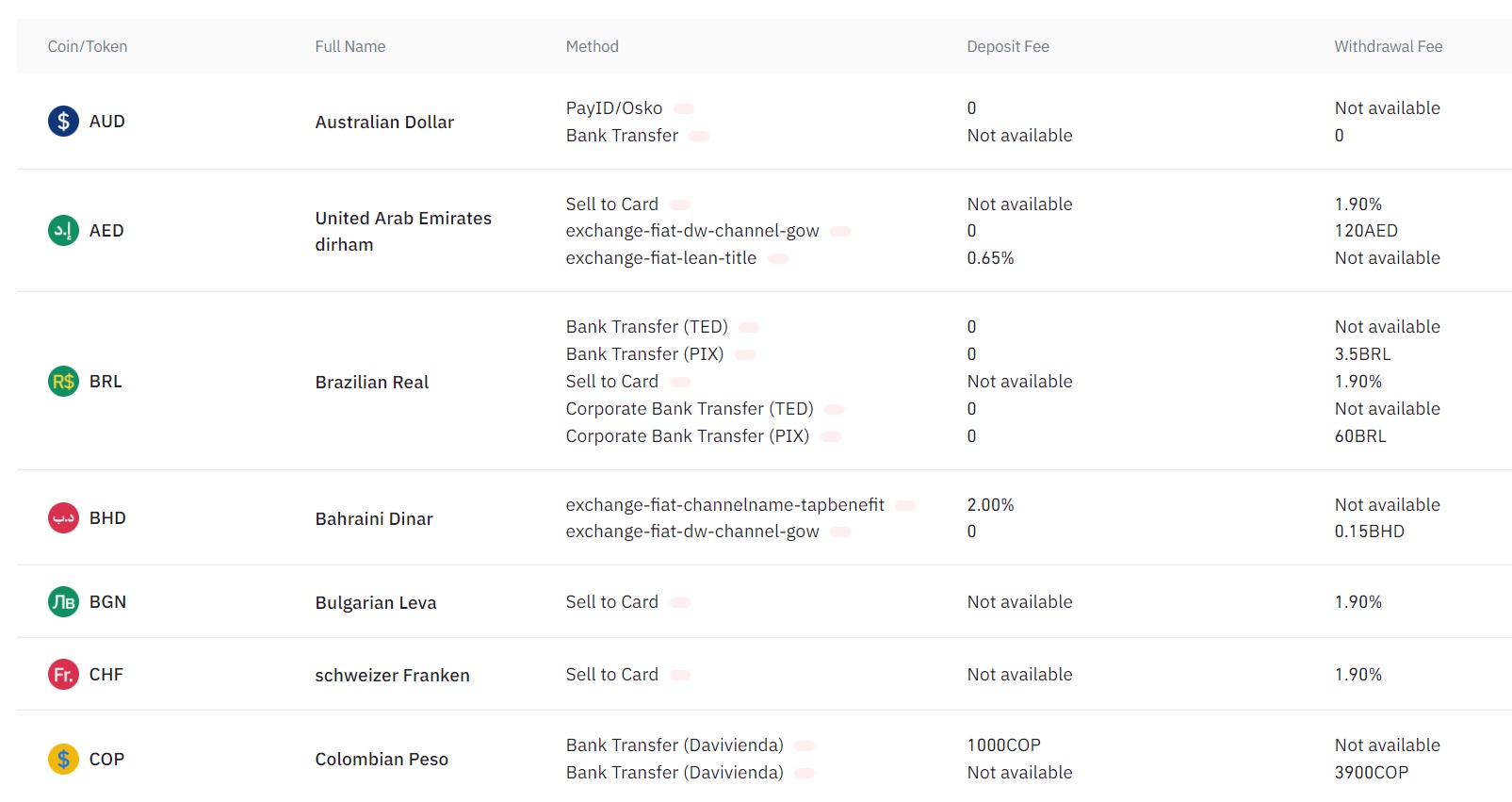
KuCoin’s supported deposit and withdrawal methods are a little more complex. Most fiat currencies cannot be directly transferred to the platform. Instead, customers must use a third-party payment gateway like Banxa, which can incur fees of 4%+. Depositing and withdrawing crypto is preferred and free.
Winner: Binance.
KuCoin’s lackluster support for fiat currency deposits and withdrawals is a limitation for individuals that want to use traditional money to buy and sell crypto. On the other hand, Binance provides good support for various fiat currencies and deposit methods across multiple jurisdictions.
Binance vs KuCoin: Trading Volume & Liquidity
Binance is the world’s #1 ranked exchange regarding its trading volume and average liquidity, according to CoinMarketCap. This makes it an excellent choice for experienced traders looking to make high-volume trades on obscure assets. Similarly, KuCoin is another strong performer in trading volume and liquidity. The platform can easily experience greater than $5B in daily trading volume at peak times. Given the exchange’s massive list of altcoins, deep global liquidity is a must for traders – and something KuCoin delivers.
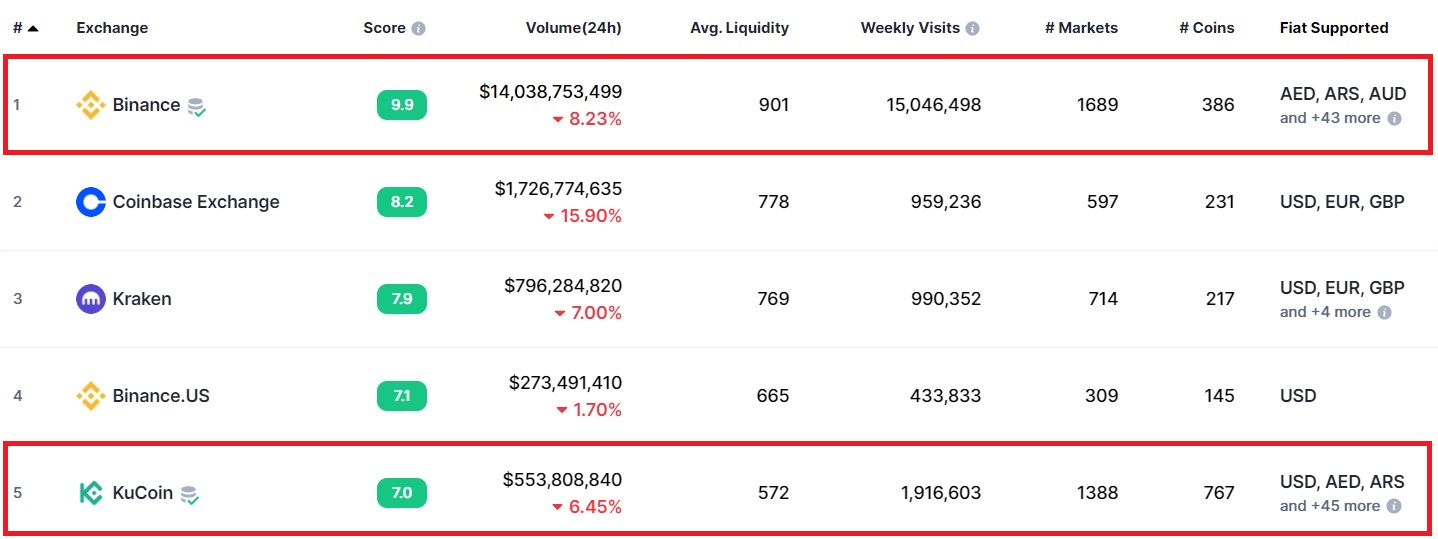
Winner: Binance.
Experienced traders needing liquidity for high-volume trades on lesser-known altcoins will find both KuCoin and Binance more than suitable. However, Binance has been the #1 exchange for spot and derivatives trading for several years which makes it almost unbeatable in this comparison.
Binance vs KuCoin: Earning Interest on Crypto
Binance has an excellent earning program with a massive range of products. The easiest to use for beginners is the “Simple Earn” service, which resembles a high-interest saving account with solid rates. These rates occasionally undergo short-term boosts where APYs on certain currencies can exceed 100% for a couple of weeks. Customers can earn interest on 300+ cryptocurrencies, which outperforms nearly all competitors. Investors can also stake their Ethereum or participate in mining pools.
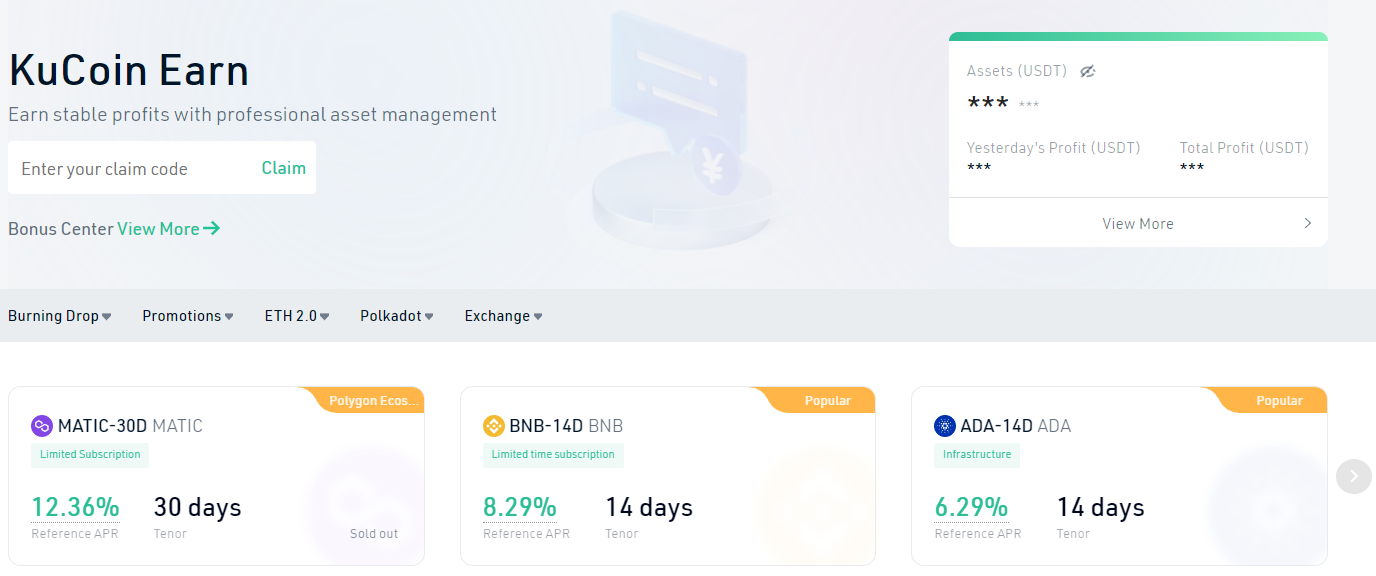
On the other hand, KuCoin has a very solid earning program with 30+ digital currencies supported. Like Binance, the specific interest rates vary from excellent (12% on NEAR) to very low (1.16% on BNB staking). Certain promotions can boost the APY on prominent coins like Ethereum to over 300%. More experienced investors can lend out their crypto, participate in Airdrops, or mine in cloud pools. KuCoin even offers a jackpot where users can buy lottery tickets for a chance to win the prize pool.
Winner: Binance.
It is hard to pick a winner between Binance and KuCoin’s earning programs, however the former slightly wins out. This is largely due to consistently higher interest rates and a broader range of earning products. However, investors will likely be satisfied with the ability to generate passive interest on either exchange.
Binance vs KuCoin: Buying & Selling NFTs
Binance has partnered with various third-party NFT marketplaces to offer some of the best collections available to its customers. This includes blue-chip NFTs like Bored Ape Yacht Club, Otherdeeds and CryptoPunks. Binance users can also mint their own NFTs on the platform, so long as they front up the gas fee (which can get quite pricey).
KuCoin has similarly partnered with a third-party service (in this case, Windvane.io) to offer customers highly sought-after NFT collections. However, what sets KuCoin apart from Binance is its fractionalized NFT service. This product allows users to buy shares in otherwise too-expensive NFTs. For example, say a MAYC NFT costs 10 ETH. Instead of having to part with the $10k+ required to buy it, a customer could instead own 1/10th of the NFT for just 1 ETH.
Winner: KuCoin.
Both Binance and KuCoin are suitable options for buying and selling NFTs thanks to their partnerships with other companies. However, we prefer KuCoin thanks to its innovative fractionalized NFT system, which helps democratize the investment process.
Binance vs KuCoin: Ease of Use
Binance isn’t exactly revered as a beginner-friendly exchange, largely because of its huge range of features. This can make it an overwhelming platform to navigate, especially for beginners who want to buy small amounts of Bitcoin. However, using Binance isn’t all that difficult once the learning curve is overcome. Its layout is solid, and most things are simple enough to find.
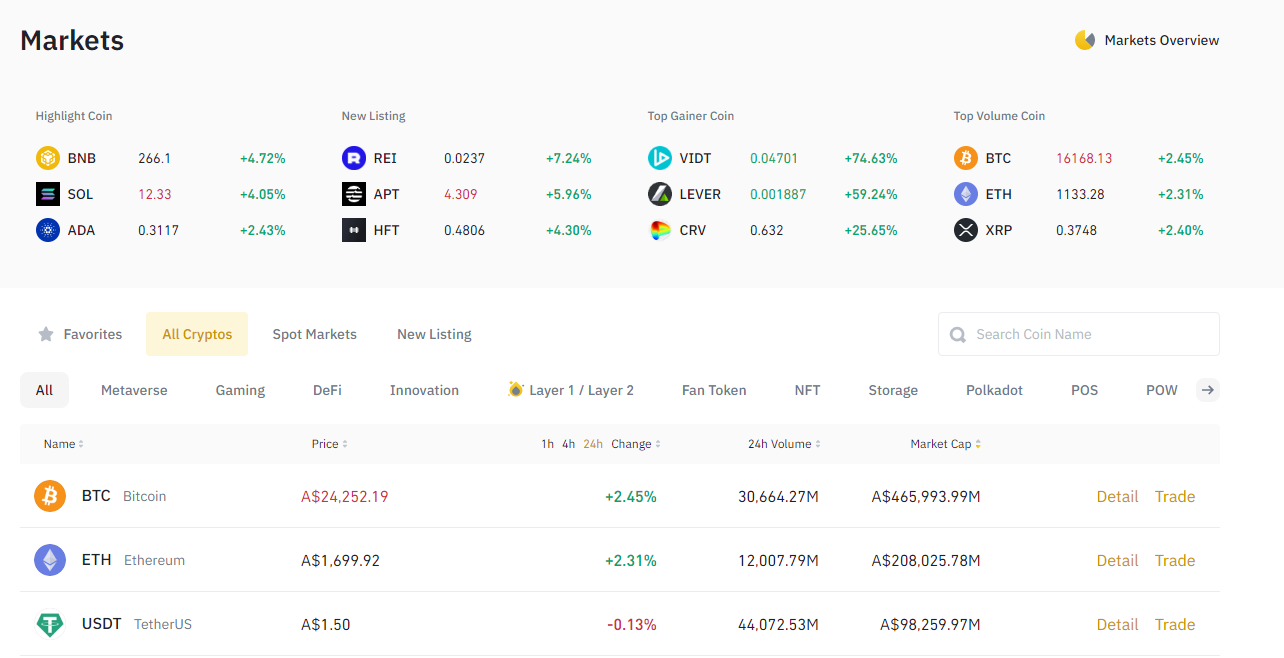
KuCoin looks almost identical to Binance, in both layout and navigational ease. This means that the platform shares many of the same issues for beginners. However, KuCoin’s interface appears slightly less professional. The font is a little difficult to read and not as well-optimized as Binance’s. In addition, English-speaking customers may find KuCoin’s copywriting to be a little clunky. That said, accessing all of the exchange’s features is quite easy once the customer gets the hang of things.
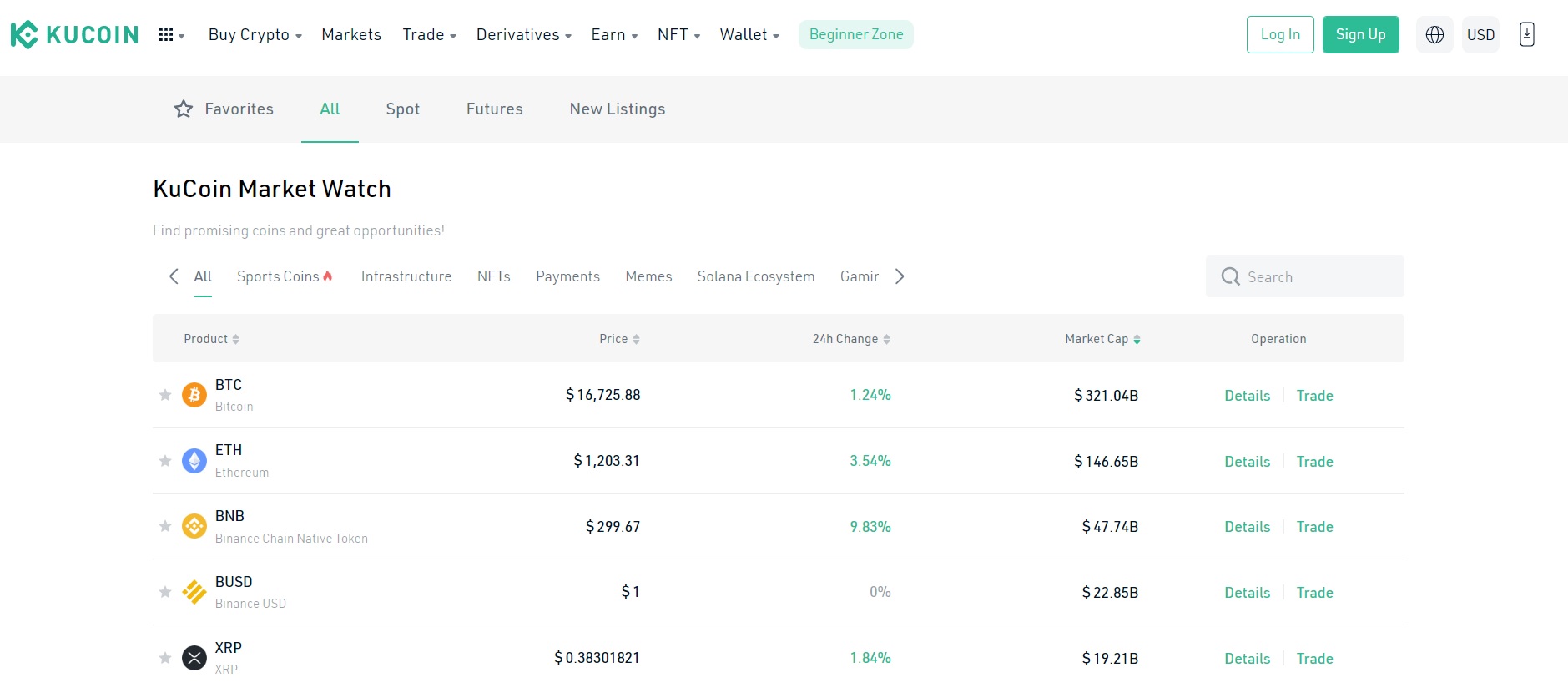
Winner: Binance.
Binance and KuCoin are remarkably similar-looking crypto exchanges, with very comparable user interfaces. However, Binance is an overall more attractive and less-cluttered crypto exchange.
Binance vs KuCoin: Supported Cryptocurrencies
Binance and KuCoin are two of the industry leaders when it comes to supported cryptocurrencies. Each platform supports 600+ digital currencies for trade, including all the major coins like Bitcoin, Ethereum, Ripple, ApeCoin, and so on. In addition, both exchanges provide access to hundreds of obscure, lesser-known altcoins while maintaining excellent liquidity.
Winner: Draw.
Although KuCoin boasts 100+ more altcoins on its platform, Binance provides greater trading pairs among crypto and fiat assets. Even the most experienced crypto investors will likely find what they’re looking for when using either of these top altcoin exchanges.
Binance vs. KuCoin: Trading Experience
Binance’s Instant Buy platform is geared toward beginners and allows customers to build a crypto portfolio in just three clicks. However, the exchange is ultimately designed for more sophisticated investors, and its spot trading hub reflects this. Binance traders will enjoy its comprehensive trading interface, with an order book, market depth, customizable crypto charting viewer and various advanced order options. Binance users can also trade derivatives, utilize leverage or adopt automated tools that automatically execute a trading strategy. There is even a dark mode available which is a nice feature.
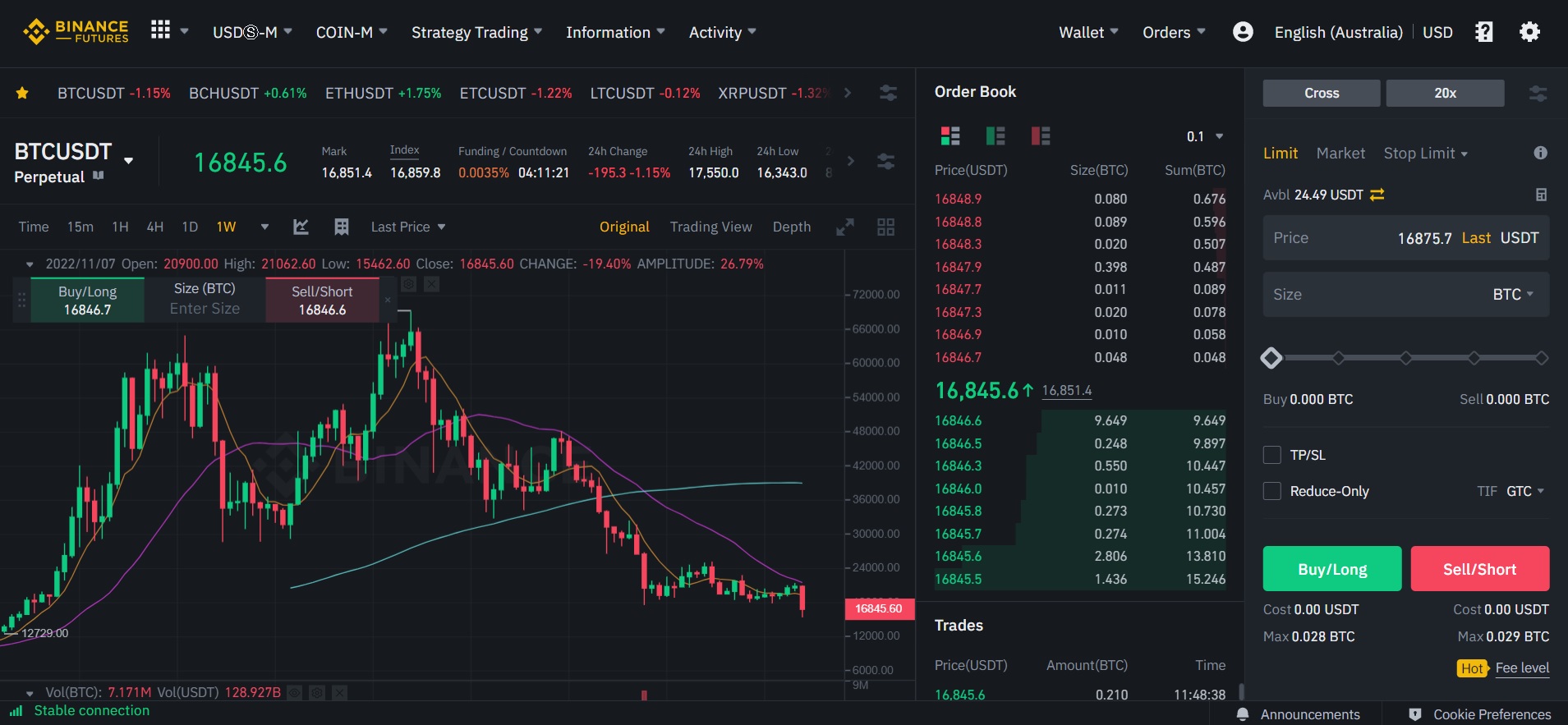
KuCoin’s main trading interface is very similar to Binance’s, although it is slightly more streamlined and easier to navigate. That said, it comes with everything you’d expect from a top-tier, modern trading interface. KuCoin users can customize their charts with hundreds of indicators, view a live-updating price feed, and trawl through the order book to leverage scalping strategies. Like Binance, KuCoin also offers margin trading (with leverage up to 100x), as well as crypto trading bots that make orders based on a pre-set strategy.
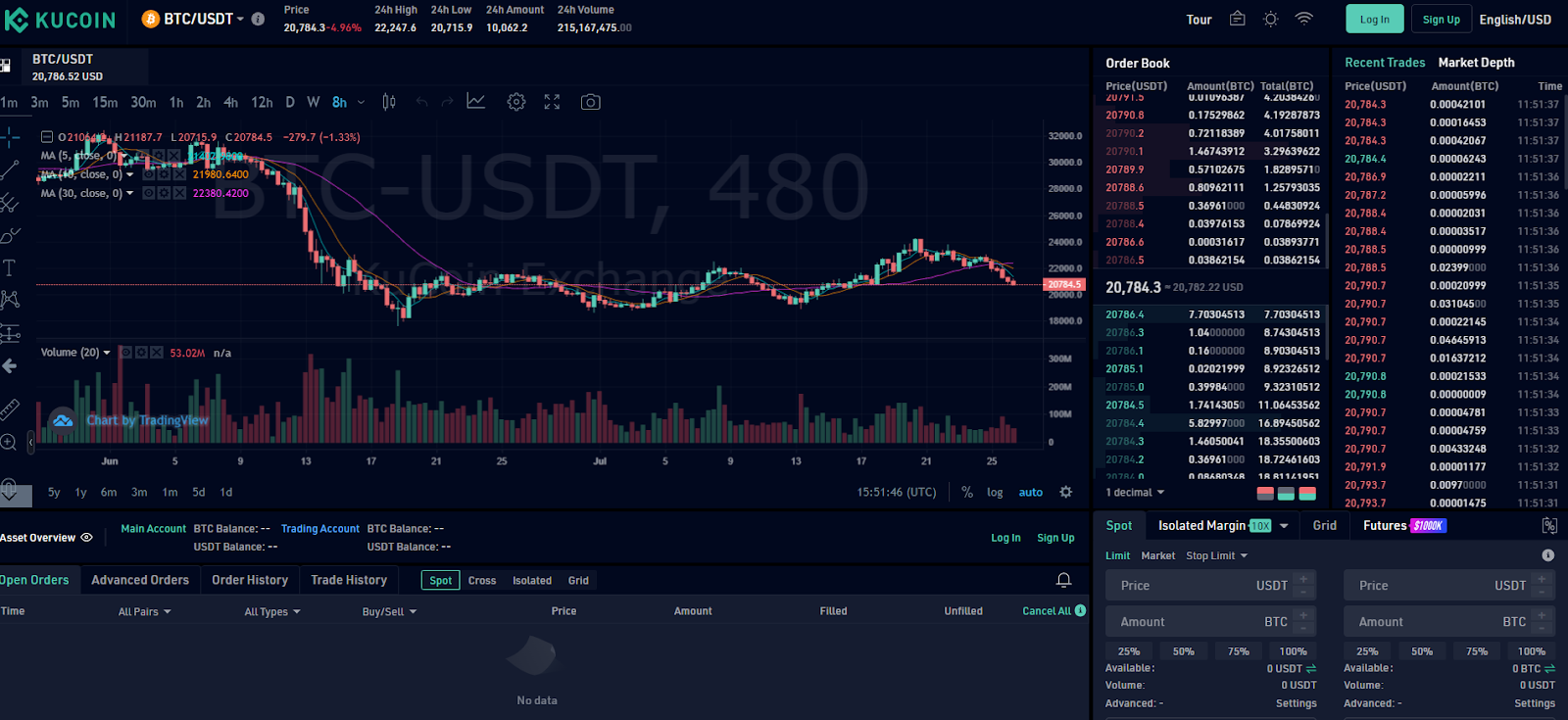
Winner: KuCoin.
KuCoin narrowly beats Binance when it comes to the trading experience. Binance is an excellent, modern exchange for traders of all experience levels, but the interface is a little clunkier to work through than KuCoin’s. In addition, KuCoin offers much greater leverage on derivatives which will suit higher-net-worth investors.
Binance vs KuCoin: Trading Fees
Binance has a competitive fee structure that starts at an industry-standard 0.1% and drops to as low as 0.06%. The discounts available when trading on Binance will vary depending on monthly trading volume and whether BNB is used to pay transaction fees. Swapping one cryptocurrency to another on Binance is free. While these fees are much more cost-effective than beginner exchanges like Coinbase or CoinSpot, they are less impressive when lined against other trading-heavy platforms such as ByBit. In addition, Binance has removed all spot fees for Bitcoin pairs. This essentially means it's a zero-fee exchange for buying Bitcoin.
| Market | Binance Fees | KuCoin Fees |
|---|---|---|
| Spot | 0% – 0.1% (with 25% discount for holding BNB) | 0.1% (with 25% discount for holding KCS) |
| Futures | From 0.02 (maker) / 0.04% (taker) | From 0.02% (maker) / 0.06% (taker) |
KuCoin's trading fees start at the same point as Binance's – 0.1%. This fee rate can be discounted too, depending on each customer's trading volume. The minimum fee for market makers with high volume is 0.0125%. This makes KuCoin one of the best platforms in the world for high-volume traders looking to save money on fees. KuCoin Futures has a slightly different fee structure, with makers charged 0.02% and takers 0.06% per trade.
Winner: Binance.
Binance and KuCoin share similarly cost-efficient fee rates for beginner/intermediate users looking to merely accumulate crypto in a long-term portfolio. KuCoin edges ahead for day traders and swing traders with higher volume, as a 0.05% difference in fees could mean saving thousands every single month. However, no trading fees on Bitcoin pairs on Binance is a significant advantage that will benefit more users.
Binance vs KuCoin: Mobile App
Binance has one of the better-designed mobile apps in the industry, available for both iOS and Android users. Thanks to the massive amount of money running through the Binance company, the development team can dedicate funds to creating and maintaining a top crypto app for traders. It's packed with features and functions, yet still easy to work through thanks to a seamless and sleek interface. The Binance app makes it easy to monitor lagging markets, earn passive income and make trades on the go. The smartphone app's lofty status in the industry is backed up by its impressive 4.7-star rating on the Apple App store.
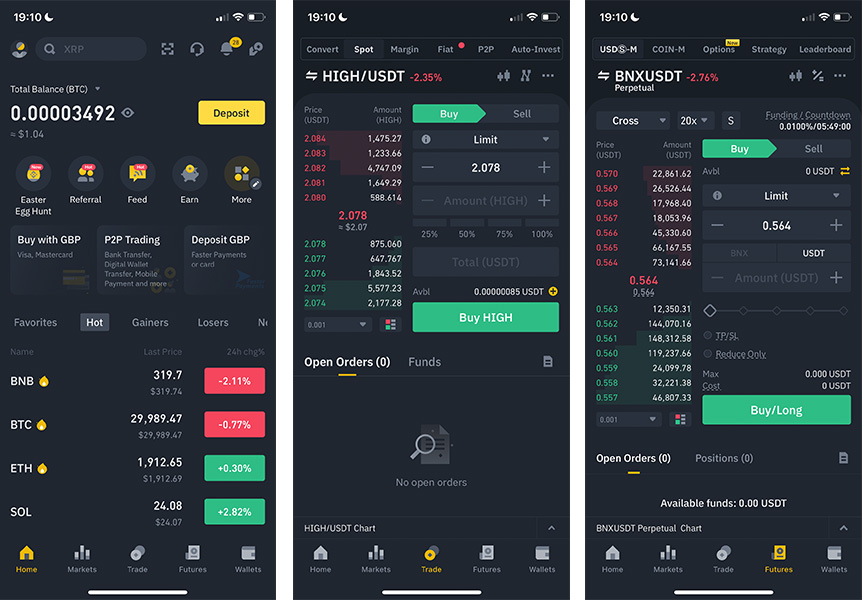
On the other hand, KuCoin’s mobile app is a strong performer, providing everything its customers would expect from a portable exchange. Whether users want to manage their portfolios while in transit, make trades at the touch of a button or participate in a lending pool, KuCoin’s app supports all the major features from its main, desktop exchange. The KuCoin app is much more suited to beginners than the website, with a solid, clean design that is simple to navigate. Its strong 4.6/5 star rating on the Apple App store reflects the user-friendly interface.
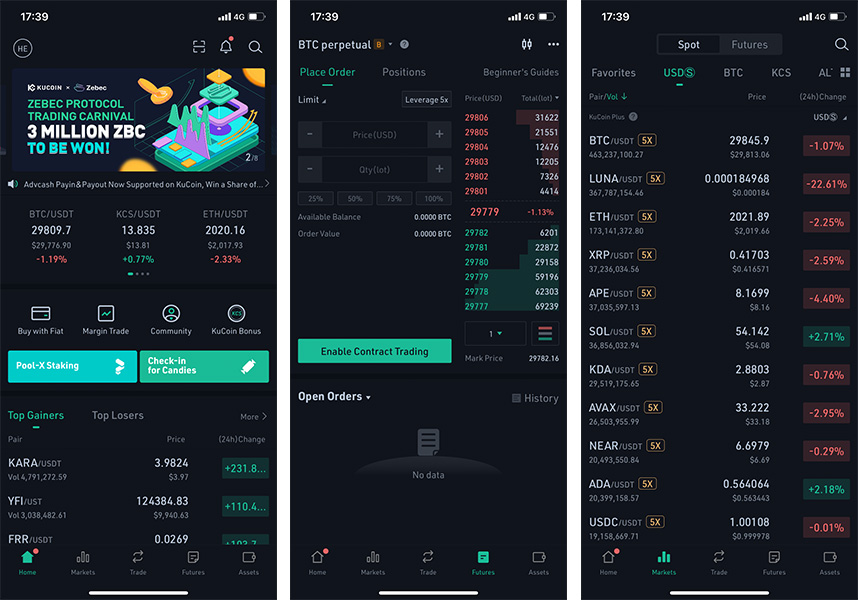
Winner: Binance.
Although KuCoin’s mobile app matches Binance’s in most respects, the latter’s app is more widely used, reputed, and popular with users. Bugs and compatibility issues are slightly more likely to occur with KuCoin’s product, which makes Binance the more-recommendable option and winner for this category.
Binance vs KuCoin: Customer Support
Binance is the world’s largest exchange by most metrics, including average weekly visits. Such heavy traffic means the company needs sound infrastructure to support the needs of so many people – something the team is still refining. Generally, the customer support isn’t adequate, with wait times for live chat and email responses quite lengthy.
However, Binance somewhat compensates with one of the industry’s best learning hubs. This includes 100+ articles walking users through the Binance basics, paired with a blog that answers both easy and difficult questions about the blockchain world.
KuCoin’s customer service is satisfactory at best. It has a reputation for being slow, with poor multi-lingual support. KuCoin users can access help via a 24/7 chatbot or by submitting a ticket and waiting for an email response. Although a rather solid learning center is available, this isn’t enough to help with more complex inquiries. The negative customer support experience is reflected by KuCoin’s 1.6/5 star rating on the review site TrustPilot.
Winner: Binance.
Binance vs KuCoin's customer support feels a little bit like a battle for which is the worst. Ultimately, Binance's written guides and learn center are some of the best in the industry, which makes up for its slow customer support. Additionally, Binance customers have reported fewer language barrier issues.
Binance vs KuCoin: Security
It's important to remember that any financial institution – crypto or otherwise – can be susceptible to exchange hacks and compromises. Therefore, finding out whether an exchange has insurance funds and Proof of Reserves in place is just as significant as understanding its various security measures.
Binance is one of the most secure platforms in the industry. The security team employs bank-like measures, including cold wallet storage for most customer assets, Two-Factor Authentication (2FA) and address whitelisting. Notably, Binance issued a Proof of Reserves, demonstrating they own all of its customers' funds. In addition, Binance has dedicated 10% of trading fees to an insurance fund, which now holds over $1 billion in assets. However, Binance was compromised a few years into its existence in 2019, when hackers made off with $40 million.
In contrast, KuCoin doesn't have the same reputation for top-tier security as Binance, largely due to its unregulated nature. The lack of regulation in the industry became a hot topic after the downfall of FTX. However, it does not inherently mean that KuCoin is more likely to be hacked than its peers. The exchange uses all the same security measures as Binance, including 2FA, hot/cold wallet storage and IP address whitelisting. Similarly, KuCoin offers an insurance fund (which paid out customers after a 2020 hack) and has also disclosed its Proof of Reserves.
Winner: Binance.
Binance comes out slightly ahead, mainly because it is regulated in quite a few more countries than KuCoin. However, in terms of fundamental security measures, both platforms can be considered quite trustworthy thanks to advanced data encryption and large insurance funds.
Final Comparison Scores
| Comparison Criteria | Winner |
|---|---|
| Features, Products and Services | Draw |
| Ease of Use | Binance |
| Trading Experience | KuCoin |
| Trading Fees | Binance |
| Mobile App | Binance |
| Security | Binance |
| Customer Support | Binance |
Ultimately, both Binance and KuCoin are strong performers in most categories other than customer support. Users who want a superior trading experience, with access to hundreds of altcoins, or even to use its crypto copy-trade platform may prefer KuCoin. On the other hand, for a more well-rounded immersion into the world of crypto, Binance is the better option.
